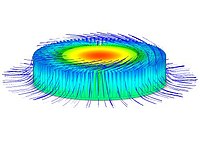
Photo from wikipedia
3-D network-on-chip (NoC) systems are getting popular among the integrated circuit (IC) manufacturer because of reduced latency, heterogeneous integration of technologies on a single chip, high yield, and consumption of… Click to show full abstract
3-D network-on-chip (NoC) systems are getting popular among the integrated circuit (IC) manufacturer because of reduced latency, heterogeneous integration of technologies on a single chip, high yield, and consumption of less interconnecting power. However, the addition of functional units in the $z$ -direction has resulted in higher on-chip temperature and appearance of local hotspots on the die. The increase in temperature degrades the performance, lifetime, and reliability, and increases the maintenance cost of 3-D ICs. To keep the heat within an acceptable limit, floorplanning is the widely accepted solution. Proper arrangement of functional units across different layers can lead to uniform thermal distribution in the chip. For systems with high density of elements, few hotspots cannot be eliminated in the floorplanning approach. To overcome, liquid microchannel cooling technology has emerged as an efficient and scalable solution for 3-D NoC. In this paper, we propose a novel hybrid algorithm combining both floorplanning, and liquid microchannel placement to alleviate the hotspots in high-density systems. A mathematical model is proposed to deal with heat transfer due to diffusion and convention. The proposed approach is independent of topology. Three different topologies: 3-D stacked homogeneous mesh architecture, 3-D stacked heterogeneous mesh architecture, and 3-D stacked ciliated mesh architecture are considered to check the effectiveness of the proposed algorithm in hotspot reduction. A thermal comparison is made with and without the proposed thermal management approach for the above architectures considered. It is observed that there is a significant reduction in on-chip temperature when the proposed thermal management approach is applied
Journal Title: IEEE Transactions on NanoBioscience
Year Published: 2017
Link to full text (if available)
Share on Social Media: Sign Up to like & get
recommendations!